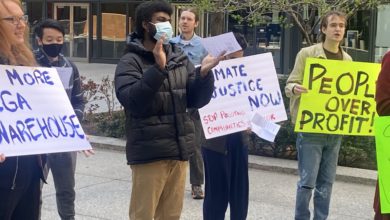For the first time in California history, the state government under Governor Jerry Brown has imposed water rationing and restrictions to address an ongoing four-year-long drought that seems to have no end. Brown announced these restrictions while standing on dry grass in an area normally covered in several feet of snow shortly after an op-ed that announced that California only had one year of water left and that snow pack was only 5 percent of its normal amount.
The bulk of these restrictions are imposed on cities and towns, which are expected to meet a mandatory 25 percent decrease in water use beginning this year. Suggested measures include rate hikes and fines levied against individual working people for their consumption. Left out of this equation, however, are the banks, oil companies, bottling industry, and an ongoing groundwater rush by farmers across the Central Valley region. Even more alarming is the lack of any long-term plan to deal with climate change and potentially more devastating droughts in the future.
Climate change and the coming ‘megadrought’
Decades of reliance on fossil fuel in the context of a profit-motivated global system has resulted in massive environmental destruction as gas emissions continue to produce a consistent rise in global temperature.
Scientists suggest that this rise in global temperature has produced more destructive weather systems in addition to massive desertification. A recent study published in Science Advances has both proven that climate change exacerbates drought, and estimated that the U.S. Southwest has a 50 percent risk of being struck with a ‘megadrought’ in the 21st century. The study defines such a drought as lasting longer than two decades and points out that reduced precipitation and increased evaporation on a global scale due to rising temperatures is the specific cause of increased drought around the world.
The megadrought predicted by scientists could lead to the drying up of California and southwestern and central plains states. This would mean tens of millions of people in the United States left in severe crisis in the course of a couple decades if no viable solution or measures are taken to prevent such an environmental catastrophe. This makes the ongoing battle for California’s resources a turning point in our history.
Who is wasting California’s water?
The restrictions imposed by Governor Brown would lead one to believe that washing dishes; watering lawns, medians, and golf courses; and filling swimming pools were mostly to blame for the conundrum that Californians find themselves in today, or that if millions of Californians took shorter showers and drove dusty cars we would be saved.
The truth is the lion’s share of water in the state is used to generate huge profits by banks, corporations, and the oil, gas, and agricultural industries.
While the process of fracking, which involves the injection of water and chemicals deep into the ground, used about 70 million gallons of water in the past year, the total waste of water from oil and gas production, including water that bubbles up from aquifers to the surface and dries up during such processes, was 42 billion gallons. This is enough water to provide for San Francisco for three years.
Wastewater from this process is also highly poisonous and is considered to be permanently removed from the water cycle. However, in the summer of 2014 the oil industry was found to have contaminated at least eight and up to 19 water wells across the Central Valley with high concentrations of arsenic and thallium (rat poison). This happened in spite of the fact that these wells are considered protected water sources under the Safe Drinking Water Act.
While Nestle has received the brunt of the heat in recent news, the truth is that Pure Life, Arrowhead, Crystal Geyser, Aquafina and Dasani are all tapping into California’s water sources across the state in over a dozen water bottling facilities. Arrowhead’s facility 85 miles east of Los Angeles in Morongo has been using between 200 and 250 million gallons a year and is leaving the Cabazon basin and Coachella Valley dry.
This is just one of these bottling plants in the state. The bottled water industry in the U.S. is estimated to produce 10 billion gallons of water with sales revenues up to $12 billion with a large portion of this revenue coming from drought-stricken California.
The biggest consumer of water in California, however, is large agribusiness. The agricultural industry in the state gobbles up 80 percent of available surface water every year as it produces 50 percent of all the fresh fruit and vegetables in the United States. Approximately 90 percent of tomatoes, grapes, broccoli, lettuce, strawberries and wine come from the state. Over 99 percent of U.S. almonds, walnuts, pistachios and over 20 percent of dairy products also comes from the region.
These figures do not include the $22 billion worth of produce that are exported all over the world for huge profits, even in conditions of severe drought. To put some of this production into perspective, it takes 700 gallons of water to produce enough alfalfa necessary for cows to produce a single gallon of milk and 425 gallons of water to produce just four ounces of beef. Producing a single almond requires at least one gallon of water.
As of last summer several rural communities in far northern sections of California, south San Francisco communities, and parts of the Central Valley region lost their source of water as wells and aquifers dried up. Many communities had to have tanker trucks pump water into their wells or have bottled water delivered and rationed during the hottest, driest months.
So what magic trick has large agribusiness managed to pull off in order to sustain billions of dollars worth of exports in addition to domestic sales, even during the longest drought in recent state history? They’ve simply drilled into the ground to tap groundwater reserves in what could only be called a “Water Rush.” Drilling for groundwater has become a norm for large agribusiness across the state and is causing tremendous irreparable damage to the environment.
Large sections of land throughout the Central Valley have sunk by 1-3 feet as farmers drill hundreds of feet deep to retrieve water. Some scientists estimate that the water being tapped by such methods fell 20,000 years ago and that the current pace of groundwater use will leave California completely dry.
Seize the profits to save the planet
The corporate media narrative around the ongoing crisis in California aims to divert and confuse the public in order to maintain the status quo of reaping tremendous profit from environmental degradation. Most reports pit various industries against one another, various individual crops against one another, or frame the problem as one between rural and urban residents for their respective consumption of water. The truth is this environmental crisis is a crisis of the capitalist system that pits a tiny handful of private owners against the masses of working people.
Large portions of some of the most water-needy crops are shipped abroad to make a profit. Billions of gallons are used by oil and gas industries, and billions more are placed in plastic and sold. All of the wealth produced in these industries by the hands of millions of workers is kept by the rich. But if this persists and California runs dry, there will be a catastrophic social crisis that could include tremendous spikes in the price of fresh food across the country and around the world, massive layoff of workers—especially farm workers—the desolation of rural communities in the state, massive internal migration, and more.
The only solutions proposed by political establishment include a series of draconian restrictions on the use of water by working people in cities, a couple hundred million dollars in federal relief, the creation of “water markets,” and the further privatization of water and water infrastructure. The corporations interested in taking over the water distribution system are backed by large banks such as Goldman Sachs, JP Morgan Chase, Deutsche Bank and Barclay’s, among others.
These huge financial institutions have nearly doubled their investments in water as the United Nations estimates global demand will outstrip supply by 30 percent as early as 2040. Local administration of water resources, private ownership, and construction of new water processing facilities are central components of the cynical drive by large banks to profit from the effects of climate change.
This means that potential solutions to the water crisis such as desalination plants and upgrading the irrigation methods of California agriculture are costly because they are meant to produce a profit for shareholders rather than meet a need for Californians. Poseidon Water, a Boston-based firm, is building the largest desalination plant in the Western Hemisphere in Carlsbad for a billion dollars. The estimated cost to switch flood irrigation systems over to drip irrigation in agriculture is believed to be $1 million for each farm.
These costs, however, are a drop in the bucket when compared to the subsidies and tax breaks received by banks, agribusiness, and the oil industry in California alone.
Immediate measures could be taken to avert the ongoing crisis if the people seized control of the profits of these industries and used them to create new sources of water and more efficient water technology. Not only could this temporarily solve the crisis of the environment, it could also improve employment for Californians by putting them to work on these infrastructure projects. Parallel to these measures should be a complete ban on fracking because of its role both in wasting and permanently poisoning water.
In the end, however, global capitalism continues to put the cost of waste production onto the environment through massive pollution, degradation and climate change. While these measures can stave off a massive social and economic crises for a period of time, they cannot on their own reverse the effects of climate change on a global scale. Only socialism, a society based on a centrally planned economy meant to meet people’s needs rather than maximize profit, can save the planet.






